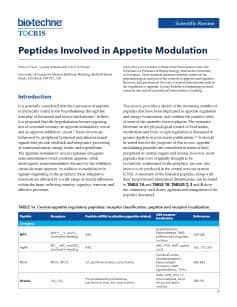Secretin Receptors
Secretin receptors are members of the glucagon receptor family that also includes glucagon, GLP-1, GLP-2, GHRH and GIP receptors. Secretin receptors are classically localized to the epithelial cells within the pancreatic and biliary ducts, where they bind to the hormone secretin.
Secretin Receptor Agonists |
|
|---|---|
| Cat. No. | Product Name / Activity |
| 1918 | Secretin (human) |
| Gastrointestinal peptide | |
| 1919 | Secretin (rat) |
| Gastrointestinal peptide | |
Secretin receptors are members of the glucagon receptor family that also includes glucagon, GLP-1, GLP-2, GHRH and GIP receptors. Secretin receptors are classically localized to the epithelial cells within the pancreatic and biliary ducts, where they stimulate the release of alkaline bicarbonate-rich fluid to neutralize acidic chyme from the stomach. This protects the duodenal mucosa and provides an optimal intraluminal environment for digestion to take place.
Secretin receptors are also found in the CNS, where they are thought to play a role in the regulation of the hypothalamic-pituitary-axis (HPA) axis. The human secretin receptor gene is localized on chromosome 2p14.1.
External sources of pharmacological information for Secretin Receptors :
Literature for Secretin Receptors
Tocris offers the following scientific literature for Secretin Receptors to showcase our products. We invite you to request* your copy today!
*Please note that Tocris will only send literature to established scientific business / institute addresses.
Peptides Involved in Appetite Modulation Scientific Review
Written by Sonia Tucci, Lynsay Kobelis and Tim Kirkham, this review provides a synopsis of the increasing number of peptides that have been implicated in appetite regulation and energy homeostasis; putative roles of the major peptides are outlined and compounds available from Tocris are listed.
